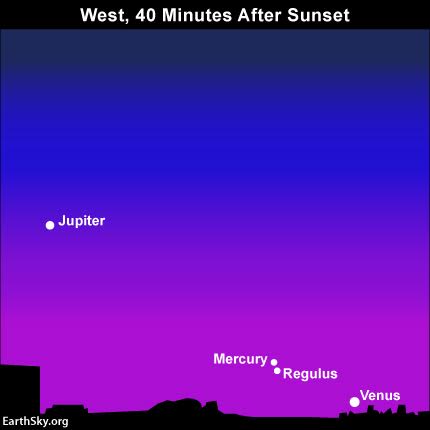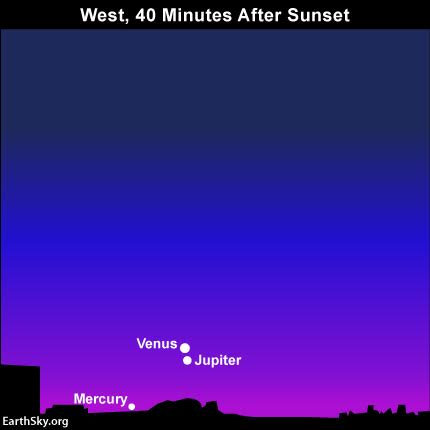
Both Venus and Mercury are in the west after sunset now as seen from around the world. Both are easier to see from Earth’s Southern Hemisphere than from the northern half of the globe. Helio C. Vital in Brazil caught the image above on July 23, 2016, shortly after sunset.
Thank you, Helio! Visit Helio’s Flickr page.
When will you see Mercury and Venus? You can see them tonight if you have an exceptionally clear western sky after sunset. Try using binoculars to scan for them near the western horizon, then remove the binoculars to see them with the eye alone.
Also, note that Mercury and Venus make a different angle with respect to the Northern Hemisphere horizon than what you see in the photo above. The chart below shows them on July 30, when Mercury will be in conjunction with the star Regulus in the constellation Leo. Read more about the Mercury-Regulus conjunction.

As the days pass, Venus will be getting higher in the sky, and it’ll become easier to see. Mercury, of course, never stays in one place in our sky for long, so if you want to catch it, look soon! Mercury will remain visible through early August.
Okay, now here’s the fun part. If you can catch Venus and Mercury now, you’ll be able to see all five bright planets at once in the evening sky! Jupiter is easy, as you can see from the chart above. Saturn and Mars are easy, too. Read more about seeing all five bright planets at once here.
Then – on August 27, 2016 – Venus and Jupiter will stage the year’s closest conjunction of two planets, with these worlds appearing only about 1/15th degree apart on the sky’s dome. For some perspective, 1/15th of a degree is the equivalent of 1/30th of the moon’s apparent diameter. That’s a very small span, and these two worlds will easily fit within the same binocular or telescopic field of view. Read more about the Venus-Jupiter conjunction here.

Bottom line: Venus and Mercury seen from Rio de Janeiro, Brazil. Plus a preview of what’s ahead for the planets – two conjunctions – and seeing all five bright planets in the evening sky!











